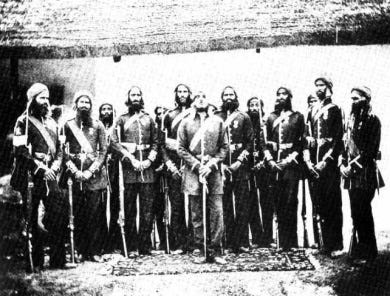KHALSA BAHADUR, by Chuhar Singh, is a 55‐page‐long poetic composition in the Malvai dialect of the Punjabi language, describing the unique chivalry and sacrifice of the twenty-one Sikh soldiers of the 36th Sikh Regiment at Saragarhi in AD 1897. Written in the baint verse form, the poem was completed on 13 November 1915 at the village Ballial, near Bhavanigarh in Patiala district. The author based his text on the information he gathered from the Sikh soldiers on leave. The poem begins with a supplication to God Almighty followed by one to the Gurus, the Guru Granth Sahib, and the Dasam Granth.
The narrative opens with the raising of the 36th Sikh Regiment, followed by an account of the Pathan tribes of the North-West Frontier Province and of the fierce battle between the Indian army and the Pathans. The strong resistance put up by a handful of twenty-one Sikh soldiers, who died to the last man defending the Saragarhi post (12 September 1897) against a horde of thousands of Afridi Pathans, has since become a legend. It has been rendered in the poem in most glowing terms. The poem also refers to the memorial monuments raised at Saragarhi, Amritsar, and Firozpur in honour of the martyrs. Although the purpose of the poet was to celebrate the gallantry of the Sikh soldier, historical fact is not disregarded. Gr.S.
References:
- ull
Khalsa Bahadur by Chuhar Singh. A Poetic Tribute to Heroism
Khalsa Bahadur is not merely a historical document in verse—it is a passionate ode to the gallantry of the Sikh soul. Composed in the Malvai dialect of Punjabi using the classic baint verse form, the poem is a 55‐page celebration of the selfless sacrifice of the twentyone Sikh soldiers of the 36th Sikh Regiment at Saragarhi in AD 1897. The poet, drawing on firsthand accounts from soldiers on leave, employs a language that vibrates with the intensity of battle and the purity of devotion.
Narrative and Structural Elements
Invocation and Sacred Beginnings:
The poem opens with a supplication to God Almighty and a subsequent invocation to the Sikh Gurus, the Guru Granth Sahib, and the Dasam Granth. This overtly sacred beginning sets a spiritual tone—a reminder that the battlefield is not only a theater of combat but also a stage for divine will and cosmic justice.
Raising the Regiment and the March to Battle:
Chuhar Singh recounts the stirring moment when the 36th Sikh Regiment was raised, imbuing the narrative with a sense of destiny and collective resolve. The poem then shifts to narrating the impending struggle against the Pathan warriors of the NorthWest Frontier Province, skillfully interweaving martial imagery with a cadence that mimics both march and meditation.
Heroic Imagery and Metaphoric Language:
The language of Khalsa Bahadur is rich in metaphors and similes. The poet elevates the forefathers of the Saragarhi defense to almost mythic status—depicting them as embodiments of truth, valor, and incorruptible honor. The stark contrast between the disciplined bravery of the Sikh soldiers and the overwhelming horde of Afridi Pathans—portrayed as an almost faceless enemy—heightens the dramatic intensity of the poem.
Names as Immortal Testaments:
One of the poem’s most striking features is its recording of the names of those who fell on the field of Saragarhi. By naming warriors such as Bhat Jaimal Singh Akali and Buddh Singh Akali among others, Chuhar Singh gives the reader a tangible sense of loss and sacrifice. This act of naming transforms individual bravery into a collective memorial—a literary attempt to preserve the echo of fallen heroes for posterity.
Cyclical and Recitative Qualities:
As with many Punjabi ballads, the recitative nature of Khalsa Bahadur lends it a musical quality. The rhythmic repetition of heroic phrases and the subtle interplay of pauses echo the cycles of struggle and victory, inviting the listener to remember and revere the courage exemplified at Saragarhi.
Themes and Cultural Significance
Valor Amidst Overwhelming Odds:
The poem captures the essence of Sikh martial ethos: a small, united force standing resolute against an overwhelming enemy. This portrayal is not meant to serve as a meticulous historical record but as an idealized, poetic encapsulation of resistance and sacrifice. It speaks to the power of unity, discipline, and faith in a time of dire crisis.
The Intersection of History and Devotion:
While Khalsa Bahadur recounts a specific event—the fabled last stand at Saragarhi—it does so through the lens of devotion. The battle is framed as a sacred duty, where the warrior’s fight is inseparable from the spiritual mandate to uphold justice, honor, and the Sikh way of life. In this way, the poem transcends mere battlefield chronicle, transforming into a hymn of liberation and moral rectitude.
Legacy and Lasting Memory:
Through its poetic form, the work ensures that the sacrifice at Saragarhi is not lost to the annals of time. Its vivid imagery and emotive language have contributed to a legacy that rekindles a sense of pride and identity among Sikhs, while also offering universal lessons on courage and honor.



